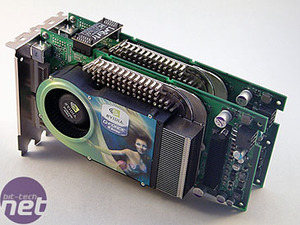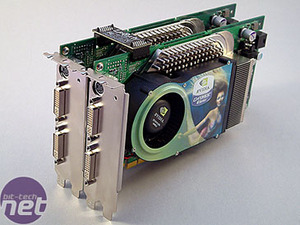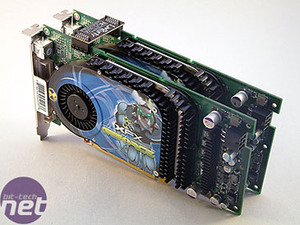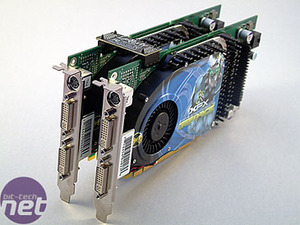
Yesterday, we had an all-important look at four NForce 4 SLI motherboards for the AMD platform from ASUS, DFI, Gigabyte and MSI. We found that the DFI LANPARTY nF4 SLI-DR was the pick of the bunch for the avid tweaker and enthusiast who wants to get the most out of their system. It is possibly the best enthusiast motherboard ever made. We don't make that sort of statement very often, but we feel that DFI have done a sterling job of implementing the NForce 4 chipset in an effective manner.
Where SLI is concerned, it's a very enthusiast-orientated platform, and thus we've chosen to use the motherboard that best suits the enthusiast for the basis of our video card evaluations. This is not to say that any of the other motherboards are not suitable for the basis of an SLI platform, we just felt that the DFI had so much more to offer to the avid hardware and gaming enthusiast that NVIDIA have aimed its SLI platform at.
Today, we are going to evaluate the performance of the GeForce 6800 Ultra and GeForce 6800 GT in SLI, focusing on how much more eye candy can be turned on when adding a second video card in to the system. Of course, it will depend on what is your favourite game, along with the rest of the system that you have installed the video cards in to. By the end of this week, we hope to cover everything that one could want to know about building a gaming system based around NVIDIA's SLI platform. There are bound to be some questions that are left unanswered, but we will be happy to answer questions as we go along, or at the end of the week's coverage.

 We teamed up with Gladiator Computers and Point of View , who supplied us with a matched pair of GeForce 6800 Ultra's for us to evaluate. The video cards follow the NVIDIA GeForce 6800 Ultra reference design pretty much right down to the line, using the same dual-slot cooler that we've previously seen on XFX's GeForce 6800 Ultra. As we mentioned back then, the GeForce 6800 Ultra is not the quietest video card we have had on our test bed, but when you are looking at one of the fastest video card solutions that money can buy, we are sure that you can put up with the proud hum, or be able to afford a third party cooling solution.
We teamed up with Gladiator Computers and Point of View , who supplied us with a matched pair of GeForce 6800 Ultra's for us to evaluate. The video cards follow the NVIDIA GeForce 6800 Ultra reference design pretty much right down to the line, using the same dual-slot cooler that we've previously seen on XFX's GeForce 6800 Ultra. As we mentioned back then, the GeForce 6800 Ultra is not the quietest video card we have had on our test bed, but when you are looking at one of the fastest video card solutions that money can buy, we are sure that you can put up with the proud hum, or be able to afford a third party cooling solution.
The pair are clocked at 425/1100MHz, which is slightly higher than the reference GeForce 6800 Ultra clock speeds, but it seems to be a typical speed that pretty much all of NVIDIA's partners are capable of shipping good volume at.

 XFX's GeForce 6800 GT's were behind a large portion of this week's coverage. We reviewed the AGP version of this video card last year, and were very impressed with it. It walked away with our recommended award and was only ousted by Gainward's supercharged GeForce 6800 GT clocked at 400/1200MHz. These cards are clocked at 350/1000MHz, which is a typical clock speed for most shipping GeForce 6800 GT's with the exception of the likes of BFG Technologies and Gainward, who offer slightly higher clock speeds on some models.
XFX's GeForce 6800 GT's were behind a large portion of this week's coverage. We reviewed the AGP version of this video card last year, and were very impressed with it. It walked away with our recommended award and was only ousted by Gainward's supercharged GeForce 6800 GT clocked at 400/1200MHz. These cards are clocked at 350/1000MHz, which is a typical clock speed for most shipping GeForce 6800 GT's with the exception of the likes of BFG Technologies and Gainward, who offer slightly higher clock speeds on some models.
Again, the heatsink design is a reference design, and the pair of fans are quiet in operation. As you will probably remember from the launch of the GeForce 6, the product shots of the GeForce 6800 Ultra had a single slot cooler, and you'd be right in thinking that the majority of GeForce 6800 GT's do overclock to baseline GeForce 6800 Ultra clock speeds (400/1100MHz) using the cooler that is shipped with the video cards. We're not guaranteeing anything here, but it's worth bearing in mind when you are considering making an upgrade to SLI.
Where SLI is concerned, it's a very enthusiast-orientated platform, and thus we've chosen to use the motherboard that best suits the enthusiast for the basis of our video card evaluations. This is not to say that any of the other motherboards are not suitable for the basis of an SLI platform, we just felt that the DFI had so much more to offer to the avid hardware and gaming enthusiast that NVIDIA have aimed its SLI platform at.
Today, we are going to evaluate the performance of the GeForce 6800 Ultra and GeForce 6800 GT in SLI, focusing on how much more eye candy can be turned on when adding a second video card in to the system. Of course, it will depend on what is your favourite game, along with the rest of the system that you have installed the video cards in to. By the end of this week, we hope to cover everything that one could want to know about building a gaming system based around NVIDIA's SLI platform. There are bound to be some questions that are left unanswered, but we will be happy to answer questions as we go along, or at the end of the week's coverage.


The pair are clocked at 425/1100MHz, which is slightly higher than the reference GeForce 6800 Ultra clock speeds, but it seems to be a typical speed that pretty much all of NVIDIA's partners are capable of shipping good volume at.


Again, the heatsink design is a reference design, and the pair of fans are quiet in operation. As you will probably remember from the launch of the GeForce 6, the product shots of the GeForce 6800 Ultra had a single slot cooler, and you'd be right in thinking that the majority of GeForce 6800 GT's do overclock to baseline GeForce 6800 Ultra clock speeds (400/1100MHz) using the cooler that is shipped with the video cards. We're not guaranteeing anything here, but it's worth bearing in mind when you are considering making an upgrade to SLI.

MSI MPG Velox 100R Chassis Review
October 14 2021 | 15:04







Want to comment? Please log in.